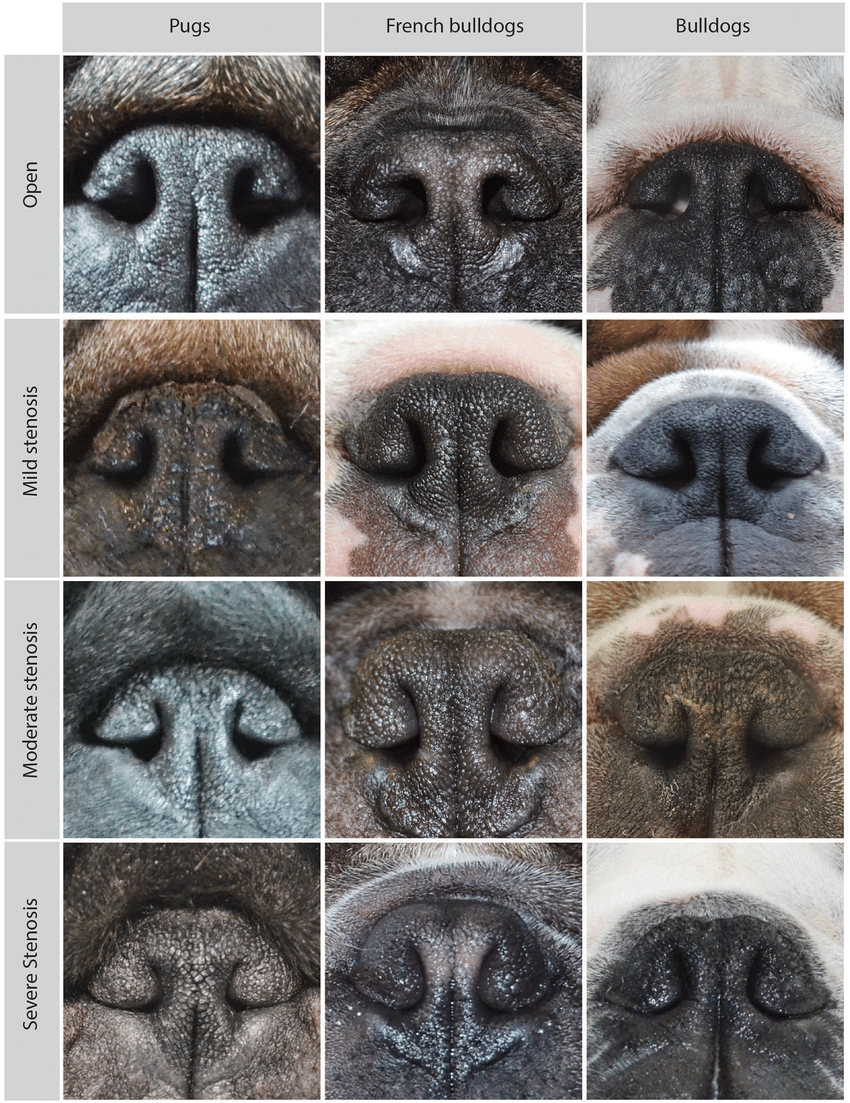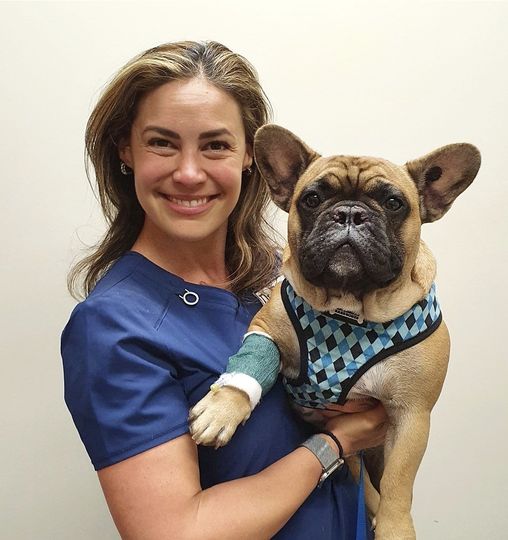What is BOAS?
Brachycephalic Obstructive Airway Syndrome (BOAS) refers to the combination of an overlong soft palate and stenotic nares (narrow nostrils). Commonly seen in brachycephalic (short-nosed) breeds, these anatomic abnormalities can subsequently lead to secondary problems.
How do these changes cause problems?
- Narrowed nostrils greatly reduce airflow through the nose.
- An overlong soft palate protrudes into the airway and blocks airflow through the larynx (voice box).
- Struggling to breath often leads to swelling and further thickening of the palate. Additionally, some dogs with BOAS are also born with a narrow trachea (windpipe).
- Stenotic nares. Negative pressure (suction) created by the anatomic malformations described above can frequently lead to progressive stages of laryngeal collapse.
- Commonly the laryngeal saccules (tissue pockets just in front of the vocal cords) turn inside out, further obstructing airflow. This may also progress to weakening and inward collapse of the vocal cords, increasing the degree of airway obstruction. Tonsil enlargement occurs due to airway inflammation causing activation of the immune system as the result of suction on these delicate structures.
- Regurgitation is also common in affected dogs due to negative airway pressures. This promotes stomach acid reflux as well as a common association with hiatal hernia (weakness of the diaphragm and valve which prevents stomach content reflux).
Symptoms:
- Dogs with elongated soft palates generally have a history of noisy breathing and snoring, especially upon inspiration (breathing inward).
- Some dogs will retch, gag or reverse sneeze due to choking on their overlong palate.
- Exercise intolerance, cyanosis (blue tongue and gums from lack of oxygen) and occasional collapse are common. Especially following over-activity, excitement or excessive heat/humidity.
- Obesity accentuates the problem by causing further airway narrowing.
- Many dogs will also regurgitate food, white froth or bile on a regular basis. The primary problem noted in some dogs.
Diagnostics:
Stenotic nares are observed on physical examination (see image below).

Body condition score (BCS) will be assessed on a scale of 1-9, (5 = normal, 1 = very underweight, 9 = obese). Mild or moderately affected dogs may undergo a 3-minute exercise test at a moderate trot to assess changes in their breathing.
Definitive diagnosis of elongated soft palate, tonsil enlargement and laryngeal collapse can only be made under very carefully monitored anaesthesia, using a laryngoscope. Chest x-rays can be taken to evaluate the trachea, lower airways and lungs for evidence of concurrent problems, especially aspiration pneumonia, which may result from inhaling regurgitated stomach contents.
It is common to also note multiple spinal abnormalities on x-rays of brachycephalic breeds (although these do not cause a clinical problem in the majority of dogs).
Additionally, dogs presenting primarily with regurgitation may undergo endoscopy of the stomach and small intestine and have biopsies taken to help exclude other causes of intestinal disease, which may be contributing to the problem.
Treatment:
- Overweight patients with mild clinical signs, will be advised of a dietary plan ahead of the procedure.
- Surgical widening of stenotic nares, by removing part of the nose folds, will help to improve nasal airflow.
- Soft palate shortening (staphylectomy) or shortening combined with thinning (palatoplasty) is performed to remove excess tissue and create space in the back of the nose and mouth, relieving obstruction of the larynx.
- If the laryngeal saccules are everted, they may be removed at the same time as the soft palate resection, or they may be left to return to a normal position if less severely affected.
- If the tonsils are enlarged and thought to be contributing to airway narrowing they may also be removed.
Aftercare and outcome:
Pets are monitored very closely in intensive care immediately after surgery and overnight thereafter. Significant inflammation or bleeding can obstruct the airway, making breathing difficult or impossible. Occasionally (around 5% of cases) a temporary tube must be placed and maintained through an incision in the neck into the trachea (tracheostomy) until the swelling in the throat
subsides enough that the pet can breathe normally.
Check out this educational video from the WSAVA HDC highlighting the problems that BOAS can cause in brachycephalic breeds, including French bulldogs, English bulldogs, and pugs.
Here at Vetkind we agree that the breeding of these dogs has become too extreme, however we are passionate about giving them the longest, happiest lives possible. We focus on brachycephalic surgery and medicine and offer the highest standard of multi level upper airway surgery as well as tailored brachycephalic anaesthesia. We will work with you to keep your squishy face healthy and thriving.
___________________________________________________________________________________________________________________________________
 About Dr Ema Bowman
About Dr Ema Bowman
Experienced New Zealand and USA trained veterinarian, Ema has a broad knowledge base that has been cultivated over 13 years. Ema graduated from Massey University in 2008 and is not only a talented Small Animal General Practitioner, but possesses a broad range of additional skills. These skills include Internal Medicine, Feline Medicine and Breed specific considerations (especially BOAS).
She is one of the very few surgeons proficient in Brachycephalic Airway Improvement Surgery (BOAS),enabling brachycephalic dogs eg. Pugs, French Bulldogs, Boston Terriers and Bulldogs to breathe!
Ema encourages any owner of a brachycephalic dog to look into this procedure. Call 07 3851 1366 to book your brachycephalic dog in for an airway assessment today!
